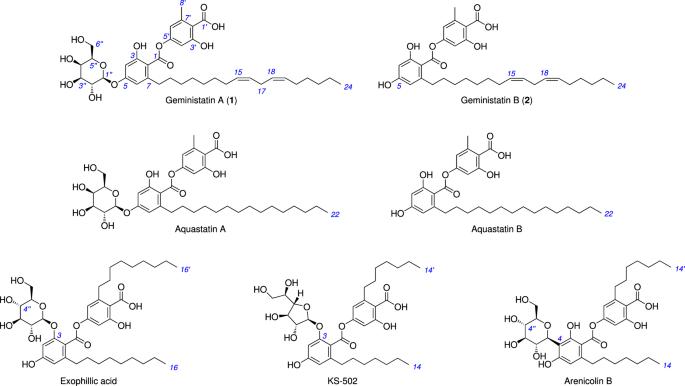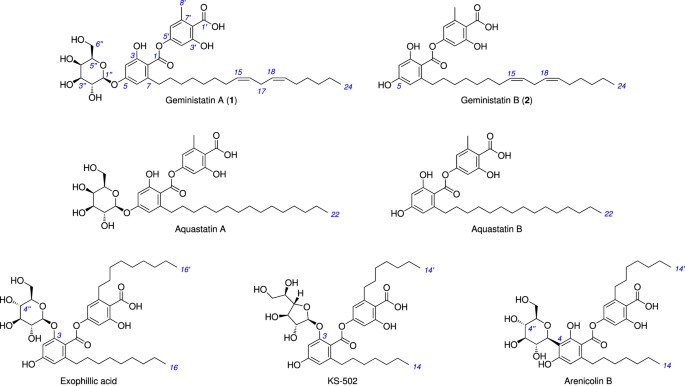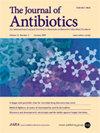Geministatins: 从真菌 Austroacremonium gemini 中提取的新型去势抗生素。
IF 2.1
4区 医学
Q3 BIOTECHNOLOGY & APPLIED MICROBIOLOGY
引用次数: 0
摘要
从澳大利亚北部潮湿热带地区的腐木中发现的真菌 Austroacremonium gemini MST-FP2131(子囊菌目,子囊菌科)中分离出了两种新的去势抗生素--geministatins A(1)和 B(2)。通过详细的光谱分析、化学降解以及与文献值的比较,阐明了 geministatins 的结构。1 和 2 的化学降解产生了三种新的类似物,即 geministatins C-E(3-5),以及一种以前报道过的化合物 dehydromerulinic acid A(6)。化合物 1、2 和 6 对革兰氏阳性细菌枯草杆菌(MIC 0.2-1.6 µg mL-1)和金黄色葡萄球菌(MIC 0.78-6.3 µg mL-1)(包括耐甲氧西林金黄色葡萄球菌(MRSA))具有抗菌活性,而化合物 4 则对酵母菌具有抗真菌活性(MIC 13 µg mL-1)。本文章由计算机程序翻译,如有差异,请以英文原文为准。


Geministatins: new depside antibiotics from the fungus Austroacremonium gemini
Two new depside antibiotics, geministatins A (1) and B (2), were isolated from the fungus Austroacremonium gemini MST-FP2131 (Sordariomycetes, Ascomycota), which was recovered from rotting wood in the wet tropics of northern Australia. The structures of the geministatins were elucidated by detailed spectroscopic analysis, chemical degradation and comparison with literature values. Chemical degradation of 1 and 2 yielded three new analogues, geministatins C–E (3–5), as well as a previously reported compound dehydromerulinic acid A (6). Compounds 1, 2 and 6 exhibited antibacterial activity against the Gram-positive bacteria Bacillus subtilis (MIC 0.2–1.6 µg mL−1) and Staphylococcus aureus (MIC 0.78–6.3 µg mL−1), including methicillin-resistant S. aureus (MRSA), while 4 exhibited antifungal activity against the yeast Saccharomyces cerevisiae (MIC 13 µg mL−1).
求助全文
通过发布文献求助,成功后即可免费获取论文全文。
去求助
来源期刊

Journal of Antibiotics
医学-免疫学
CiteScore
6.60
自引率
3.00%
发文量
87
审稿时长
1 months
期刊介绍:
The Journal of Antibiotics seeks to promote research on antibiotics and related types of biologically active substances and publishes Articles, Review Articles, Brief Communication, Correspondence and other specially commissioned reports. The Journal of Antibiotics accepts papers on biochemical, chemical, microbiological and pharmacological studies. However, studies regarding human therapy do not fall under the journal’s scope. Contributions regarding recently discovered antibiotics and biologically active microbial products are particularly encouraged. Topics of particular interest within the journal''s scope include, but are not limited to, those listed below:
Discovery of new antibiotics and related types of biologically active substances
Production, isolation, characterization, structural elucidation, chemical synthesis and derivatization, biological activities, mechanisms of action, and structure-activity relationships of antibiotics and related types of biologically active substances
Biosynthesis, bioconversion, taxonomy and genetic studies on producing microorganisms, as well as improvement of production of antibiotics and related types of biologically active substances
Novel physical, chemical, biochemical, microbiological or pharmacological methods for detection, assay, determination, structural elucidation and evaluation of antibiotics and related types of biologically active substances
Newly found properties, mechanisms of action and resistance-development of antibiotics and related types of biologically active substances.
 求助内容:
求助内容: 应助结果提醒方式:
应助结果提醒方式:


